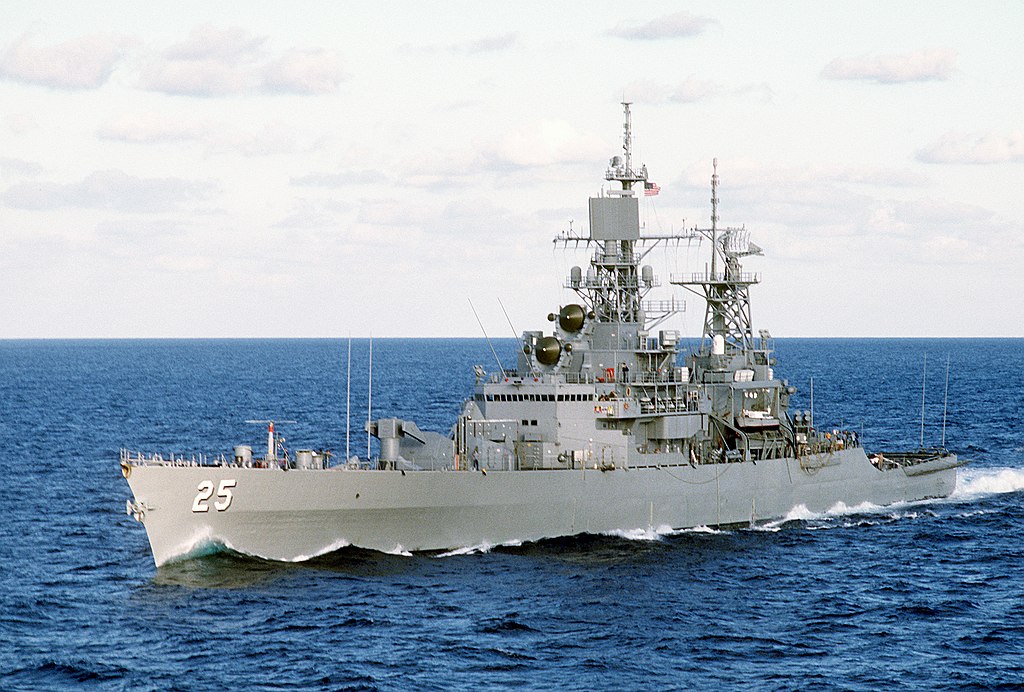
The tenth Leahy went nuclear
Destroyer nuclear propulsion was given high priority from about 1956 onwards because of destroyer endurance initially, not carrier endurance, which had been a limiting factor in carrier task force operations. However for the USS Bainbridge, tenth guided missile destroyer of the Leahy class (frigate even as planned) was also as a complement to the costly Long Beach (CGN-9), latest nuclear-powered missile guider cruiser planned to escort the equally new USS Enteprise (CVN-65). The USS Bainbridge (DDLG 25, CGN 25 from 1975) was essentially a nuclear-powered equivalent of the Leahy class, built as the prototype nuclear fast task force escort. At the time she represented the minimum platform for a two-reactor power plant which could be expected to attain destroyer speed; a fast submarine plant, such as that in the large USS Triton, was rejected because it weighed too much for the power it produced to propel a destroyer with a worthwhile payload at an acceptable speed. Bainbridge would late have an AAW modernisation at Puget Sound (30 June 1974-24 September 1976, completed at San Diego April 1977) which saw her fitted with a large deckhouse aft for NTDS, 3-in/50 replaced by 20mm guns and then by quadruple Harpoon canisters (1979). She had two Phalanx installed during refit October 1983 until April 1985, SPS-37 radar replaced by SPS-49, SLQ-32(V)3 and RBOC chaff launchers installed and Mk 14 weapons direction system (NTU).
Bainbridge would late have an AAW modernisation at Puget Sound (30 June 1974-24 September 1976, completed at San Diego April 1977) which saw her fitted with a large deckhouse aft for NTDS, 3-in/50 replaced by 20mm guns and then by quadruple Harpoon canisters (1979). She had two Phalanx installed during refit October 1983 until April 1985, SPS-37 radar replaced by SPS-49, SLQ-32(V)3 and RBOC chaff launchers installed and Mk 14 weapons direction system (NTU).
Construction
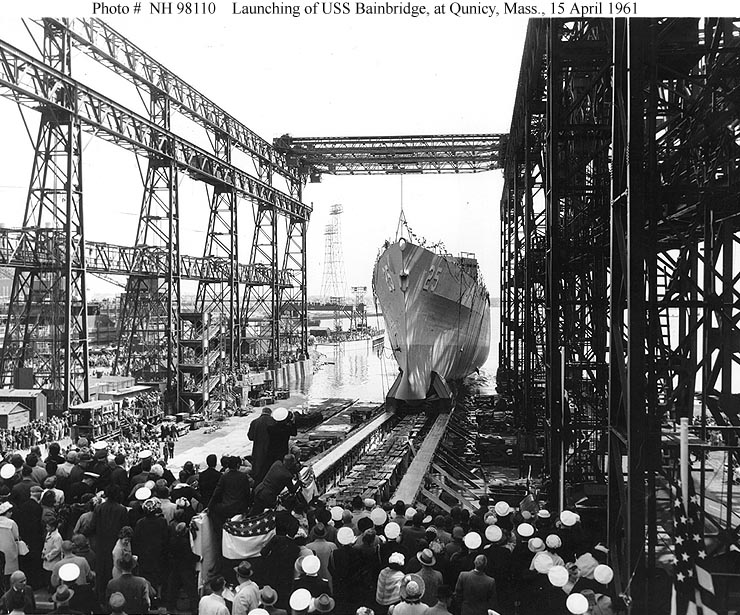 USS Bainbridge is launched at the Bethlehem Steel Company shipyard, Quincy, Massachusetts. Official U.S. Navy Photograph, from the Collections of the Naval Historical Center #NH 98110.
USS Bainbridge was designed and built by Bethlehem Shipbuilding Corp., Fore River Shipyard, Quincy, Massachusetts. She was ordered on xxx, laid down on xxx, launched on 15 April 1961 and commissioned in October 1962, so just xxx years.
[caption id="attachment_47570" align="aligncenter" width="700"]
USS Bainbridge is launched at the Bethlehem Steel Company shipyard, Quincy, Massachusetts. Official U.S. Navy Photograph, from the Collections of the Naval Historical Center #NH 98110.
USS Bainbridge was designed and built by Bethlehem Shipbuilding Corp., Fore River Shipyard, Quincy, Massachusetts. She was ordered on xxx, laid down on xxx, launched on 15 April 1961 and commissioned in October 1962, so just xxx years.
[caption id="attachment_47570" align="aligncenter" width="700"]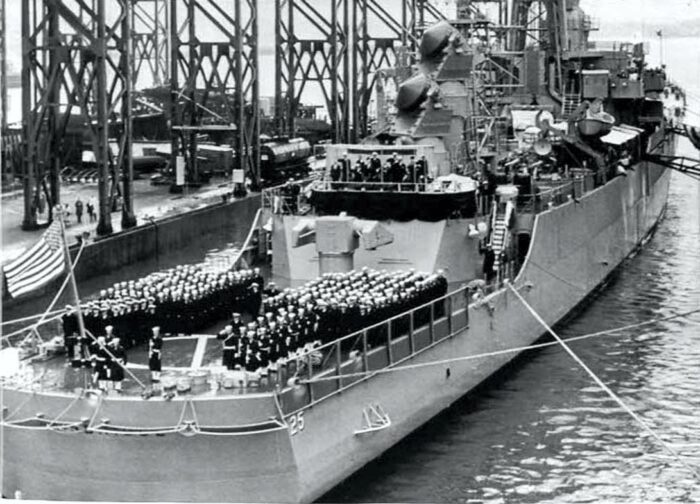 Commissioning ceremonies, at the Bethlehem Steel Company shipyard, Quincy, Massachusetts, 6 October 1962.
Commissioning ceremonies, at the Bethlehem Steel Company shipyard, Quincy, Massachusetts, 6 October 1962.Official U.S. Navy Photograph, from the Collections of the Naval Historical Center #NH 98111.[/caption]
Design of the class
Hull and general design
 Conway's profile of the class. She was 32 feet longer (9.7 meters).
Conway's profile of the class. She was 32 feet longer (9.7 meters).
 Comparative between USS Bainbridge and the Leahy class.
The main design of USS Bainbridge followed the same blueprint as for the Leahvy class, and just an additional section built-in. She was indeed 565 feet long (172 meters) versus 533 feet for the Leahy (162 meters). This additional section was forward, as the prow was way further apart from the superstrctures. The Bainbridge was also wider, at 57.75 ft (17.60 m) instead of 55 ft (17 m) and deeper in draught at 29 ft (8.8 m) mean versus 26 ft (7.9 m). This was traduced immediately by a displacement increase of 1,200 tonnes filly loaded.
Comparative between USS Bainbridge and the Leahy class.
The main design of USS Bainbridge followed the same blueprint as for the Leahvy class, and just an additional section built-in. She was indeed 565 feet long (172 meters) versus 533 feet for the Leahy (162 meters). This additional section was forward, as the prow was way further apart from the superstrctures. The Bainbridge was also wider, at 57.75 ft (17.60 m) instead of 55 ft (17 m) and deeper in draught at 29 ft (8.8 m) mean versus 26 ft (7.9 m). This was traduced immediately by a displacement increase of 1,200 tonnes filly loaded.
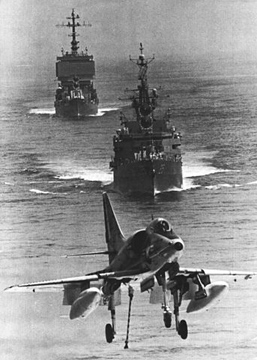 Her silhouette in general also changed. Having no funnel, there was no support (mast-stack or mack) for the radars, so instead derrick masts were built as believed to be strong enough for future upgrades and potentially even heavier radars. Like the Leahy class, the main armament (Terrier SAM) was split between the prow and stern, making her a typical "double ender", a configuration repeated on the following Belknap and Truxtun, as well as the Virginia and West Carolina class or even the Ticonderoga class.
The forward bridge was the same with a tiered-faced, three storey high block with wings. The forward two dish-like fire control radars were mounted superfiring on top of the bridge, the same was repeated aft. The aft superstructure origially was very low, just one deck high, with a large utilitarian surface and two davits for four utility boats. The torpedo tubes were amidships and the two 3-in AA mounts further aft. The derrick foremast supported three radars and was higher than the stockier, shorted mainmast aft. It was a unusual and perhaps less appealing, balanced, than the Leahy, but strickly utilitarian.
Her silhouette in general also changed. Having no funnel, there was no support (mast-stack or mack) for the radars, so instead derrick masts were built as believed to be strong enough for future upgrades and potentially even heavier radars. Like the Leahy class, the main armament (Terrier SAM) was split between the prow and stern, making her a typical "double ender", a configuration repeated on the following Belknap and Truxtun, as well as the Virginia and West Carolina class or even the Ticonderoga class.
The forward bridge was the same with a tiered-faced, three storey high block with wings. The forward two dish-like fire control radars were mounted superfiring on top of the bridge, the same was repeated aft. The aft superstructure origially was very low, just one deck high, with a large utilitarian surface and two davits for four utility boats. The torpedo tubes were amidships and the two 3-in AA mounts further aft. The derrick foremast supported three radars and was higher than the stockier, shorted mainmast aft. It was a unusual and perhaps less appealing, balanced, than the Leahy, but strickly utilitarian.
Powerplant
The USS Bainbridge of course did not repeated the Leahy's powerplant, at least completely. The Leahy's two steam turbines were fed by four boilers provided 85,000 shp (63 MW). The boilers of course by the larger two General Electric Reactors, D2G type, mated to similar Geared Turbines and still two propeller shafts. However the rated output was less officially at 60,000 shp. Still, she was able to reach 34 kn (63 km/h; 39 mph) on trials, so more than the Leahy at 32 knots (59 km/h; 37 mph). This paradox was even accentuated by her unlimited range, versus the Leahy's 8,000 nautical miles at cruise speed. USS Bainbridge made a high speed run across the Atlantic to join the "nuclear battle group" in 1966 (see later) without issue, but concerns of wear and tear on the turbines quickly limited these kind of exercizes. On peacetime, this was carefully managed. Both her turbines and nuclear reactors gave satisfaction during her overall service.Armament
2x2 RIM-2 Terrier Mk-10 SAM
2 twin armed launchers were installed at each end of the ship with 80 missiles total in storage. Same specs and systems as fo the Leahy class:MK 112 ASROC Launcher ASUW
Standard RUR-5A system also present on the Leahy class, installed forward, just in front of the bridge. The system fired up to eight missiles but had no reload.Two triple 12.75 in (324 mm) torpedo tubes ASUW
Standard light triple ASW torpedo tubes bank fring the acoustic Mark 46 Torpedo. Usable by remote electric drive or manual backup, torpedo reloaded manually. Mark 46 torpedoes (or Mark 44 if fitted with these, the Mark 46 was only in service by 1967. The Mark 44 was a 32 pounds (196 kg), 8.2 feet (2.5 m) long by 12.75 inches (32.4 cm) acoustic, Helix search model powered by a 30 hp(22 kW) electric engine propelled out the tubes at 123 metres per second (400 ft/s) over 123 metres (135 yd) and capable of for 30 knots (56 km/h; 35 mph) over 3.4 miles (5.5 km) and to reach 1,000 yards (910 m) in depth. It carried a 75 pounds (34 kg) Mk 101 Mod 0 HBX-31 Warhead coupled with the Mk 19 type Mod 12 contact exploder.2×3-inch/50 AAW
This early AA installation for extra safety was ordered by Kennedy in 1960. The mounts were located xxxx. They were removed in order to install Harpoon installation in eight canisters, two mounts of four pointing either side.After Refit
By September 1976 her two Terrier SAM and four SPG-55 radars were removed. In place were installed two similar twin arm Standard SM-1MR SAM (80 RIM-66) and this was completed by SPG-55B radars for guidance, as well as the LN-66 and SPS-43 radars. In 1978 her 76mm/50 AA mounts were removed for two 20mm/70 Oerlikon Mk 10 which took far less space, as well as two Mk 35 radars. The next year, these Oerlikon were removed and two quadruple canisters of Harpoon SSM (8 RGM-84A) were added as prime antiship capability, to which was installed the NTDS CCS. In 1985 the Standard SM-1MR were removed and replaced by Standard SM-2ER SAM (80 RIM-67 in store) and two twin, two sextuple barrel 20mm/76 Mk 15 Phalanx were installed for anti-ship missile work as well as four single 12.7mm/90 to deal with asymetric warfare. The ASROC was not removed but just deactivated. As for sensors, the SPS-37, SPS-39, SPS-43, SPS-10F radars and SQS-23 sonar as well as the WLR-1 and WLR-3 ECM suites and Mk 28 decoy RL were removed. In place were installed the SPS-48C, SPS-49, and SPS-67 radars, two guiding Mk 90 radars for the SM-2 and the new SQQ-23A PAIR sonar. For electronic warfare she was setup with the SLQ-32(v)3 ECM suite and received four of the new Mk 36 SRBOC decoy rocket launcher and well as the T-Mk 6 Fanfare torpedo decoy.RIM-66 (SM-1/SM-2) Standard SAM
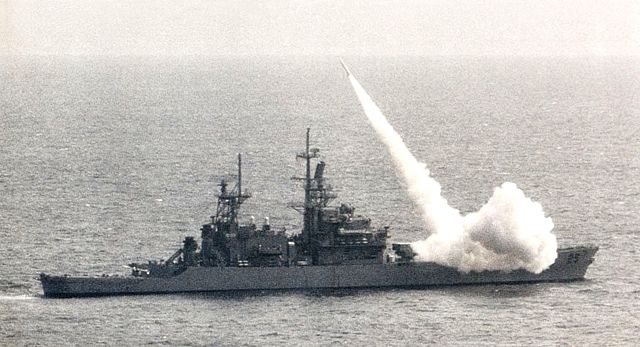 Launching Standard ER Missiles in 1992
The Upgrade took place in 1978 for the SM-1 and 1985 for the SM-2. On average, it uses dual thrust with solid-fuel rocket and a 40 to 92 nmi (74 to 170 km) range, 25,000 m (82,000 ft) ceiling at
Mach 3.5 (4,290 km/h; 2,660 mph; 1.19 km/s), with a Blast fragmentation warhead using Radar and contact fuze.
Launching Standard ER Missiles in 1992
The Upgrade took place in 1978 for the SM-1 and 1985 for the SM-2. On average, it uses dual thrust with solid-fuel rocket and a 40 to 92 nmi (74 to 170 km) range, 25,000 m (82,000 ft) ceiling at
Mach 3.5 (4,290 km/h; 2,660 mph; 1.19 km/s), with a Blast fragmentation warhead using Radar and contact fuze.
AGM-84 Harpoon SSM
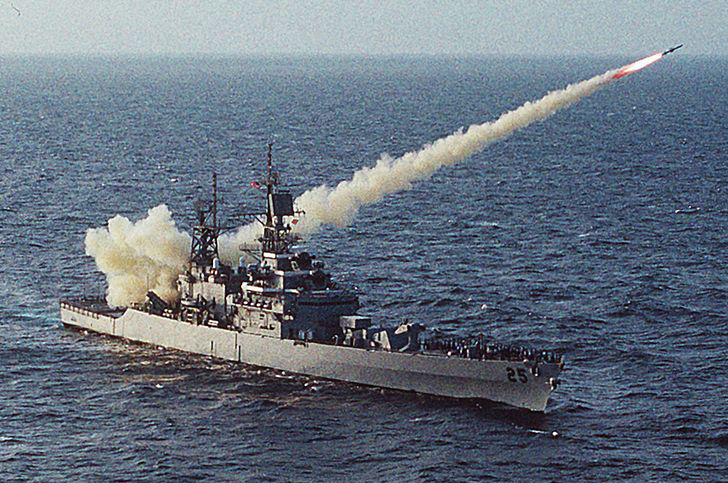 Launching AGM-84 Harpoon Missiles on January 1992
Two sets of four canisters installed amidship, in between structures, facing port and starboard.
Quickspecs (Block I): Warhead 488 pounds (221 kg) on Impact fuze. 537 mph (864 km/h; 240 m/s; Mach 0.71) range 75 nmi (139 km). Guidance Sea-skimming using radar altimeter, active radar terminal homing.
Launching AGM-84 Harpoon Missiles on January 1992
Two sets of four canisters installed amidship, in between structures, facing port and starboard.
Quickspecs (Block I): Warhead 488 pounds (221 kg) on Impact fuze. 537 mph (864 km/h; 240 m/s; Mach 0.71) range 75 nmi (139 km). Guidance Sea-skimming using radar altimeter, active radar terminal homing.
BGM-109 Tomahawk SSM
Eight BGM-109 Tomahawk were installed in two armored box launchers, located on either side abaft the rear strcture, facing aft. Quickspecs: 98–164 ft (30–50 m) cruising alt. at ~Mach 0.74. or 567.7 mph, guided by GPS, INS, TERCOM, DSMAC, active homing UGM-109B. 1,000 pounds (450 kg) conventional warhead or W80 nuclear, tactical. Range (Block 4) 864 nmi (1000+ miles, 1600+ km).Phalanx CIWS
Two Phalanx CIWS, six-barrel guns were installed for antiship missiles, located over the rear structure, one on each side.Sensors
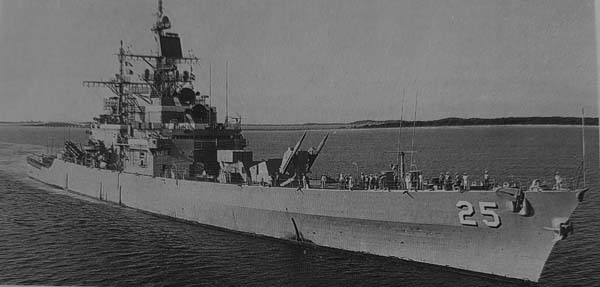 The Sensors and processing systems suite comprised the following:
One AN/SPS-10 surface search RADAR
One AN/SPS-37 search RADAR
One AN/SPS-52 3D air search RADAR[3]
Four AN/SPG-55 Terrier fire control radars
A fixed radome AN/SQS-26 sonar
The Sensors and processing systems suite comprised the following:
One AN/SPS-10 surface search RADAR
One AN/SPS-37 search RADAR
One AN/SPS-52 3D air search RADAR[3]
Four AN/SPG-55 Terrier fire control radars
A fixed radome AN/SQS-26 sonar

⚙ specifications | |
| Displacement | 9,100 tons fullly loaded |
| Dimensions | 565 x 57.75 x 29ft (172 x 17.60 x 8.8 m) |
| Propulsion | 2 shafts, 2x Geared Turbines fed by two G.E. Reactors (D2G) 60,000 shp |
| Speed | 34 kn (63 km/h; 39 mph) |
| Range | Unlimited |
| Armament | 2x RIM-2 Terrier Mk-10, 2×3-in/50, MK 112 ASROC, 2x3 12.75 in (324 mm) ASWTT, see notes |
| Sensors | AN/SPS-10, AN/SPS-37, AN/SPS-52, 4x AN/SPG-55 Terrier, AN/SQS-26 sonar |
| Crew | 556 (43 Officers, 513 enlisted) |
Read More/Src
Books
Conway's all the world's fighting ships 1947-1995.Links
ussbainbridgeassociation.com/ on navsource.org/ history.navy.mil/ on nvr.navy.mil web.archive.org news.navy.mil jfk.artifacts.archives.gov history.navy.mil bainbridge-iv.html wikipedia.org hullnumber.com/CGN-25 seaforces.org/ www.navysite.de/ on shipsnostalgia.com navypedia.org/ What were the lessons of combat service of USS Bainbridge (CGN-25)? Why were no more nuclear guided missile cruisers built for the USN? on commons.wikimedia.orgVideos
https://youtu.be/P5Al7AY-8RAModel Kits
on scalemates.com/ Not many choices here. Bainbridge was covered by Aurora at 1:600, JAG at 1:700 and Argos by Jeorg Uter at 1:1250. It seems there was a 1:350, see below. kit review on totalnavy.com/3D

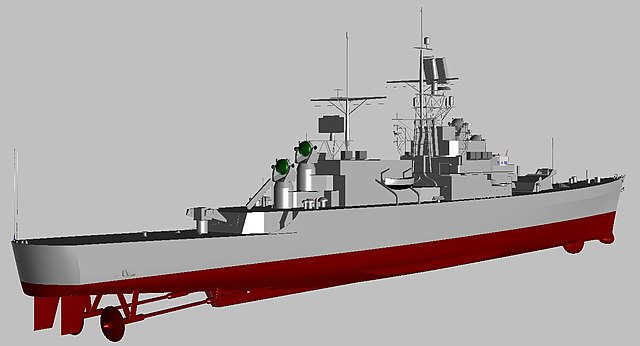 both creative commons (see link)
both creative commons (see link)

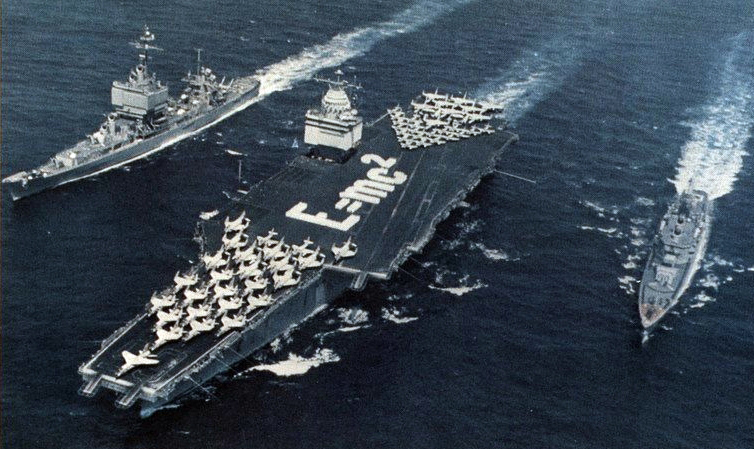
 USS Bainbridge with USN Task Force One in 1964
After commissioned and fitting out, early yard tests, she started East Coast initial training, then made a short shakedown cruise in the Caribbean until February 1963. She was back for post-fixes and when done, was deployed for her first Mediterranean tour. During this first overseas deployment she put to good use her powerplant, showing a long-range high-speed record for crossing the Atlantic and joining
USS Bainbridge with USN Task Force One in 1964
After commissioned and fitting out, early yard tests, she started East Coast initial training, then made a short shakedown cruise in the Caribbean until February 1963. She was back for post-fixes and when done, was deployed for her first Mediterranean tour. During this first overseas deployment she put to good use her powerplant, showing a long-range high-speed record for crossing the Atlantic and joining 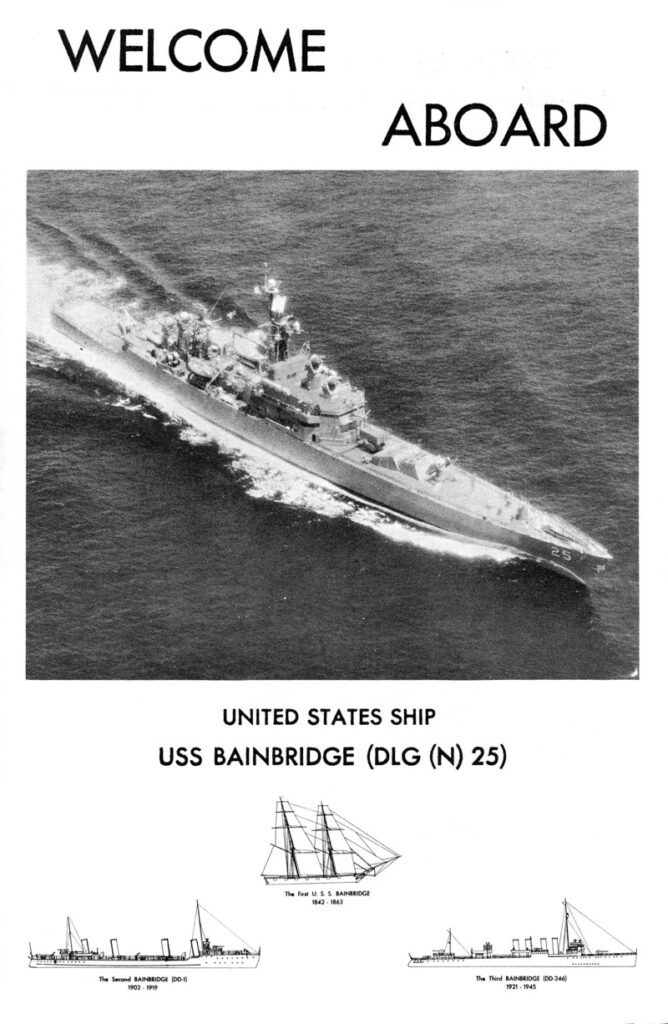 Welcome Aboard booklet, cover, circa 1966-1969 showing previous ships of the name, provided by Darryl Baker, http://www.navsource.org
USS Bainbridge returned to the Mediterranean by May 1964. Again, in CVN-65 Battle Group and alongside USS Long Beach, just commissioned, to form the all-nuclear-powered Task Force 1, making a "showing the flag" cruise and demonstrating the world's first all-nuclear battlegroup. By late July they started Operation "Sea Orbit", a groundbreaking 30,565 mile, or 65 day at sea without resplenlishment, around the world. She later was back home for maintenance.
Welcome Aboard booklet, cover, circa 1966-1969 showing previous ships of the name, provided by Darryl Baker, http://www.navsource.org
USS Bainbridge returned to the Mediterranean by May 1964. Again, in CVN-65 Battle Group and alongside USS Long Beach, just commissioned, to form the all-nuclear-powered Task Force 1, making a "showing the flag" cruise and demonstrating the world's first all-nuclear battlegroup. By late July they started Operation "Sea Orbit", a groundbreaking 30,565 mile, or 65 day at sea without resplenlishment, around the world. She later was back home for maintenance.
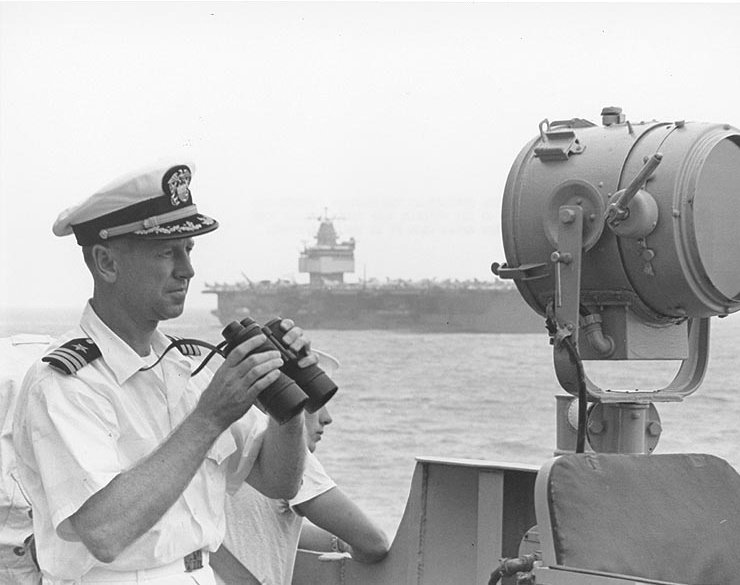 The XO of Bainbridge scanning the horizon, with USS Enteprise seen behind.
In October 1965, USS Bainbridge rounded Cape Agulhas for the Western Pacific, making the first of eleven deployment with the 7th fleet and Vietnam, screening aircraft carriers, used as radar-picket and performing SAR missions (search and rescue) with her only helicopter. In June 1966, she returned to be homeported to Long Beach in California. She would make five more of these deployment, by 1966–67, 1969, 1970, 1971 and 1972–73, mixing Vietnam War combat operations but also pacific exercizes, visits to Hong-Kong, Singapore, Japan, Australia and from the mid-1970s, the Indian Ocean. In 1967–1968 she underwent her first major overhaul and first nuclear refueling. Her 7th WestPac tour of duty started by November 1973, included a lengthy visit to the Indian Ocean and Arabian Sea, a locale that would become very familiar in the coming decades.
The XO of Bainbridge scanning the horizon, with USS Enteprise seen behind.
In October 1965, USS Bainbridge rounded Cape Agulhas for the Western Pacific, making the first of eleven deployment with the 7th fleet and Vietnam, screening aircraft carriers, used as radar-picket and performing SAR missions (search and rescue) with her only helicopter. In June 1966, she returned to be homeported to Long Beach in California. She would make five more of these deployment, by 1966–67, 1969, 1970, 1971 and 1972–73, mixing Vietnam War combat operations but also pacific exercizes, visits to Hong-Kong, Singapore, Japan, Australia and from the mid-1970s, the Indian Ocean. In 1967–1968 she underwent her first major overhaul and first nuclear refueling. Her 7th WestPac tour of duty started by November 1973, included a lengthy visit to the Indian Ocean and Arabian Sea, a locale that would become very familiar in the coming decades.
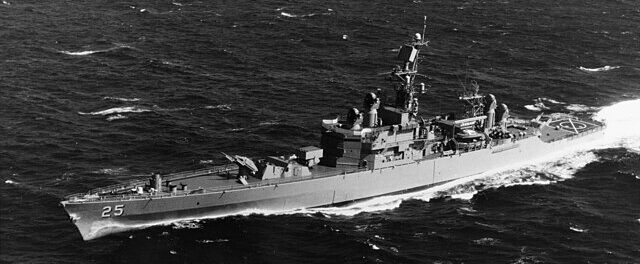 Underway in the Pacific March 1971
Bainbridge received an extensive modernization and refueling between June 1974 and September 1976, plus a post-overhaul until April 1977. By June 1975 she became a cruiser, designated CGN-25. She sortied to the 7th Fleet from January to August 1978, also visiting Japan, South Korea, Thailand, Singapore and training with these allied fleets, completing this with Australia and a South Pacific tour before setting sail for home. She would make three more WestPac tours: 1979–80, 1981, 1982–83, operating in the Indian Ocean, Arabian Sea to answer the needs of the troubled middle east, especially after the 1979 crisis with Iran, but also Lebanon, Libya, etc. In 1982 she won the Marjorie Sterrett Battleship Fund Award for her performances.
Underway in the Pacific March 1971
Bainbridge received an extensive modernization and refueling between June 1974 and September 1976, plus a post-overhaul until April 1977. By June 1975 she became a cruiser, designated CGN-25. She sortied to the 7th Fleet from January to August 1978, also visiting Japan, South Korea, Thailand, Singapore and training with these allied fleets, completing this with Australia and a South Pacific tour before setting sail for home. She would make three more WestPac tours: 1979–80, 1981, 1982–83, operating in the Indian Ocean, Arabian Sea to answer the needs of the troubled middle east, especially after the 1979 crisis with Iran, but also Lebanon, Libya, etc. In 1982 she won the Marjorie Sterrett Battleship Fund Award for her performances.
 Off Long Beach in April 1971
Back home she received a final nuclear refueling overhaul by 1983–85 and after crossing the Panama Canal, was back with the U.S. Atlantic Fleet. At that stage, she was involved with the Coast Guard into intensive counter-drug smuggling patrols in the Caribbean. She also made several northern European waters deployments, and four more Mediterranean rours, in 1986–87, 1988–89 (war patrol off Libya) and 1991–92 (Red Sea/Persian Gulf deployment) and 1994 for the Standing Naval Force Atlantic (STANAVFORLANT) and applying UN resolutions for Operation Sharp Guard, the arms blockade and air interdiction over Serbia.
[caption id="attachment_47581" align="aligncenter" width="640"]
Off Long Beach in April 1971
Back home she received a final nuclear refueling overhaul by 1983–85 and after crossing the Panama Canal, was back with the U.S. Atlantic Fleet. At that stage, she was involved with the Coast Guard into intensive counter-drug smuggling patrols in the Caribbean. She also made several northern European waters deployments, and four more Mediterranean rours, in 1986–87, 1988–89 (war patrol off Libya) and 1991–92 (Red Sea/Persian Gulf deployment) and 1994 for the Standing Naval Force Atlantic (STANAVFORLANT) and applying UN resolutions for Operation Sharp Guard, the arms blockade and air interdiction over Serbia.
[caption id="attachment_47581" align="aligncenter" width="640"]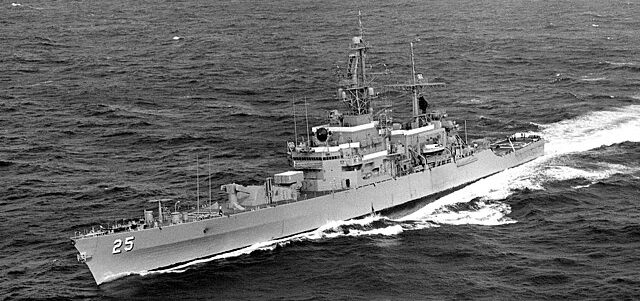 An aerial port bow view of the nuclear-powered guided missile cruiser USS BAINBRIDGE (CGN 25) underway in October 1982.[/caption]
She proceeded to over 100 boardings, inspecting cargo. She also supported Operation Deny Flight, as "REDCROWN" (coordinator of air warfare operations) over Bosnia. Her renewed AAW suite after 1985 allowed to make a full radar cover of the airspace as well as the Adriatic, having her new SM-2 ER missiles ready for any engagement with the capability of engaging 16 aircraft/cruise missiles at the same time up to 75 nautical miles (139 km) away.
An aerial port bow view of the nuclear-powered guided missile cruiser USS BAINBRIDGE (CGN 25) underway in October 1982.[/caption]
She proceeded to over 100 boardings, inspecting cargo. She also supported Operation Deny Flight, as "REDCROWN" (coordinator of air warfare operations) over Bosnia. Her renewed AAW suite after 1985 allowed to make a full radar cover of the airspace as well as the Adriatic, having her new SM-2 ER missiles ready for any engagement with the capability of engaging 16 aircraft/cruise missiles at the same time up to 75 nautical miles (139 km) away.
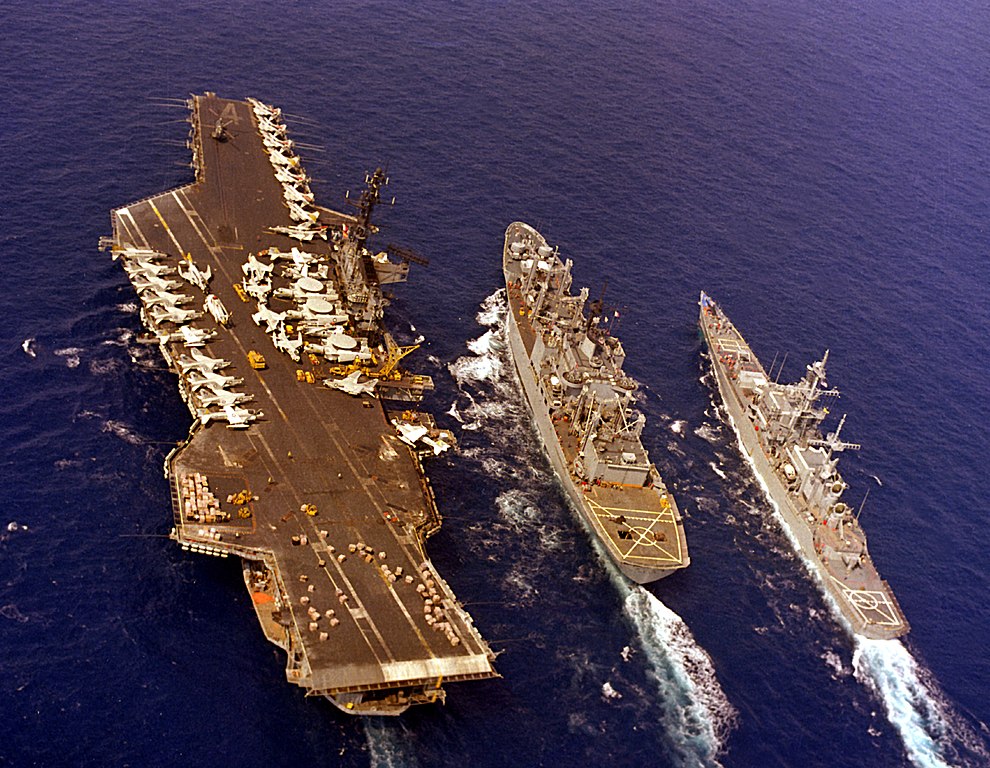 With USS Midway in 1984
She went back a last time at the end of the year, and preparations for inactivation were made, by October 1995, officially decommissioned in September 1996 and later towed to Bremerton in Washington via the Panama Canal by mid-1997. She stayed there until October and started a drydock period of recycling, a long process of nuclear-contaminated materials and disposal under strict procedure for safety. This went one for years. Her complete scrapping was over at Puget Sound Naval Shipyard on 30 OCT 1999.
With USS Midway in 1984
She went back a last time at the end of the year, and preparations for inactivation were made, by October 1995, officially decommissioned in September 1996 and later towed to Bremerton in Washington via the Panama Canal by mid-1997. She stayed there until October and started a drydock period of recycling, a long process of nuclear-contaminated materials and disposal under strict procedure for safety. This went one for years. Her complete scrapping was over at Puget Sound Naval Shipyard on 30 OCT 1999.
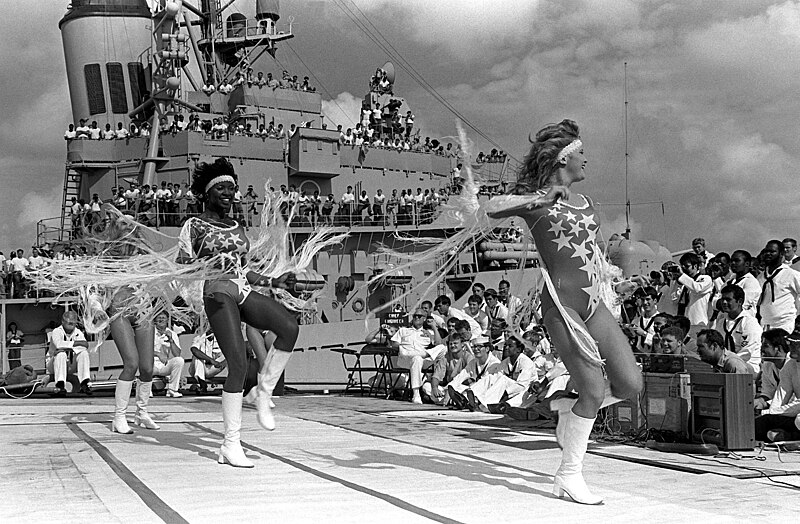 Dallas Cowboy Cheerleaders perform aboard USS Bainbridge in 1983
For her long service she was awarded 8 battle stars and Vietnam Service Medal, two Joint Meritorious Unit Award and two Navy Meritorious Unit Commendation from the Coast Guard, a Navy Meritorious Unit Commendation five Navy Battle "E", the Navy Expeditionary Medal and National Defense Service Medal, eight Armed Forces Expeditionary Medals the Southwest Asia Service Medal, the Humanitarian Service Medal, nine Sea Service Deployment Ribbon, the Coast Guard Special Operations Service Ribbon, Republic of Vietnam Gallantry Cross Unit Citation, Republic of Vietnam Civil Action 1st Class Unit Citation, Republic of Vietnam Campaign Medal and Kuwait Liberation Medal.
Dallas Cowboy Cheerleaders perform aboard USS Bainbridge in 1983
For her long service she was awarded 8 battle stars and Vietnam Service Medal, two Joint Meritorious Unit Award and two Navy Meritorious Unit Commendation from the Coast Guard, a Navy Meritorious Unit Commendation five Navy Battle "E", the Navy Expeditionary Medal and National Defense Service Medal, eight Armed Forces Expeditionary Medals the Southwest Asia Service Medal, the Humanitarian Service Medal, nine Sea Service Deployment Ribbon, the Coast Guard Special Operations Service Ribbon, Republic of Vietnam Gallantry Cross Unit Citation, Republic of Vietnam Civil Action 1st Class Unit Citation, Republic of Vietnam Campaign Medal and Kuwait Liberation Medal.
 Bainbridge underway in 1991
[caption id="attachment_47590" align="aligncenter" width="725"]
Bainbridge underway in 1991
[caption id="attachment_47590" align="aligncenter" width="725"]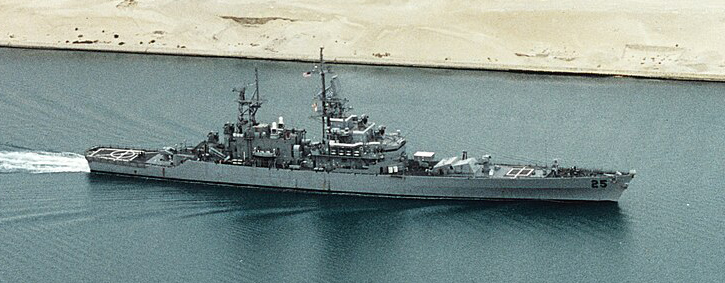 USS Bainbridge (CGN-25) Underway in the Suez Canal on 27 February 1992, while en route to the Mediterranean Sea with the USS Dwight D. Eisenhower (CVN-69) battle group. Photographed by CWO2 A.A. Alleyne, USN. Official U.S. Navy Photograph, from the Collections of the Naval History and Heritage Command.[/caption]
USS Bainbridge (CGN-25) Underway in the Suez Canal on 27 February 1992, while en route to the Mediterranean Sea with the USS Dwight D. Eisenhower (CVN-69) battle group. Photographed by CWO2 A.A. Alleyne, USN. Official U.S. Navy Photograph, from the Collections of the Naval History and Heritage Command.[/caption]